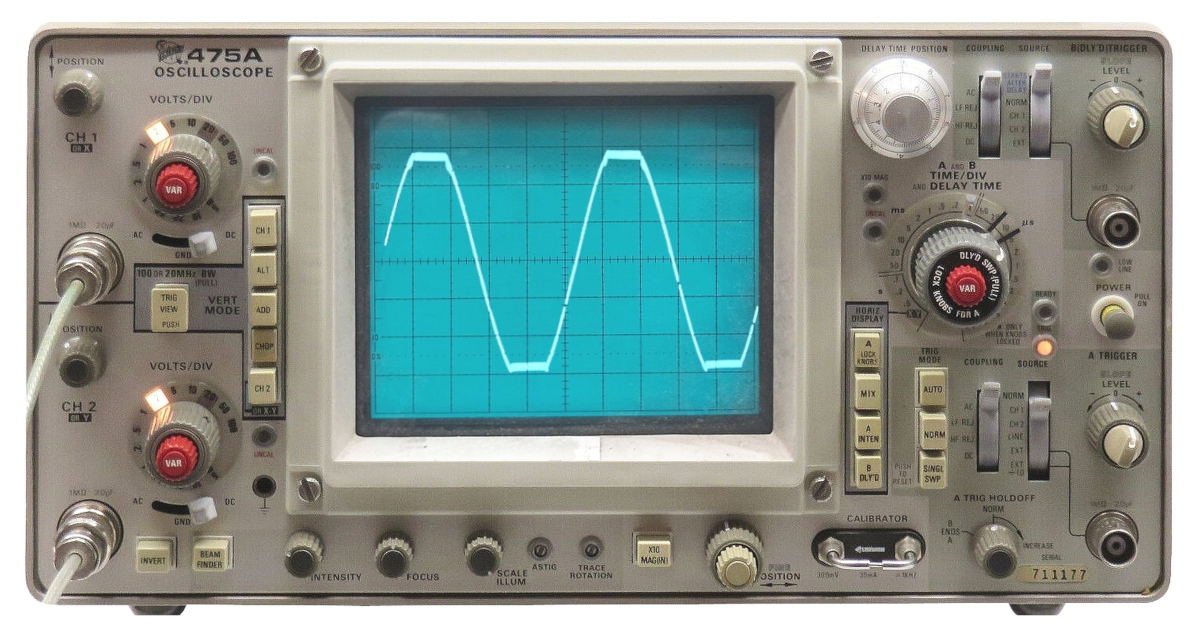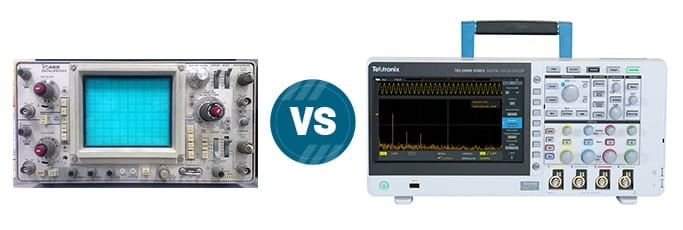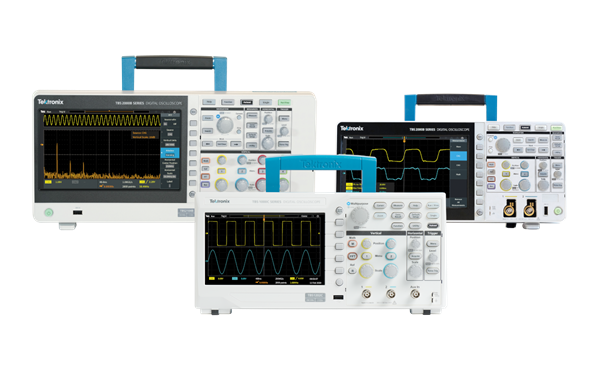

Introduction
Imagine diagnosing complex electronic issues with a tool that has stood the test of time: the analog oscilloscope. This article takes you through the journey of this indispensable instrument, from its historical roots to modern applications. Although Analog Oscilloscopes are no longer manufactured, our Digital Oscilloscopes can read Analog signals.
Historical Context
The journey of the analog oscilloscope begins with the development of the cathode ray tube (CRT) in the early 20th century. These initial devices, known as cathode ray oscilloscopes, marked the genesis of electronic waveform visualization. Since their inception in the 1940s, analog oscilloscopes have undergone significant evolution, shaping the way electronic signals are analyzed and interpreted. This historical advancement has been pivotal in the progression of electronic testing and research, laying the foundation for modern electronics.
Understanding Analog Oscilloscopes
These devices graphically represent electrical signals, converting voltage into a visual format displayed on a screen. This conversion is crucial for observing the behavior of electrical signals, such as frequency, amplitude, and distortion, offering an intuitive understanding of electronic signal characteristics.
Operational Mechanics
Central to an analog oscilloscope's operation is the CRT, where an electron beam forms a visible trace of the measured electrical signal. This process involves:
- Vertical Amplification: Enhancing the input signal for display on the Y-axis (voltage).
- Timebase Control: Managing the beam's horizontal sweep, setting the time scale on the X-axis.
- Horizontal Amplification: Enhancing the horizontal deflection signal.
Components
Analog oscilloscopes comprise several key components that collectively facilitate their operation:
- Cathode Ray Tube (CRT): The core element where electron beams form images on a screen.
- Vertical Amplifier: Increases the amplitude of the input signal for effective display.
- Timebase: Manages the horizontal sweep rate of the beam, determining the display's time scale.
- Horizontal Amplifier: Enhances the horizontal deflection signal.
- Power Supply: Provides the necessary electrical power for the oscilloscope's operation.

Practical Applications
These oscilloscopes are versatile, used in educational labs, electronic repair, research and development, and hobbyist projects, for tasks ranging from teaching to troubleshooting.
Maintenance and Calibration
Proper maintenance and periodic calibration are essential for preserving the accuracy and functionality of analog oscilloscopes. Routine procedures include:
- Regular Cleaning: Dust and debris can accumulate in the CRT and other components, affecting performance.
- Component Checks: Regular inspection for wear and tear, especially in older models, is crucial.
- Calibration: Regular calibration ensures measurement accuracy and compensates for component aging and environmental changes.
Bridging Theory and Practice
Analog oscilloscopes are educational tools that connect theoretical electronics concepts with real-world applications, making them invaluable in learning environments.
Aesthetic Appeal
The way analog oscilloscopes display waveforms has an aesthetic quality, especially appealing in fields like audio engineering where waveform nuances are important.
Audio Engineering Applications
In audio engineering, analog oscilloscopes are crucial for analyzing audio signals, assessing sound quality, and ensuring fidelity in recordings and live setups.
Role in Vintage Electronics Restoration
Their compatibility with older technology makes analog oscilloscopes essential in restoring vintage electronics, a growing interest among enthusiasts and professionals.
Customization and Modification
The potential for customization and modification of analog oscilloscopes is a unique aspect, allowing for increased bandwidth, improved sensitivity, or artistic uses.
Environmental Perspective
Continued use of analog oscilloscopes represents a form of electronic recycling, contributing to environmental sustainability by reducing electronic waste.
Scientific Research Applications
In scientific research, these oscilloscopes are preferred for capturing transient events and anomalies, where immediate visual feedback is essential.
Challenges and Future Outlook
Despite their advantages, analog oscilloscopes face challenges such as limited storage and advanced features compared to digital models. However, their specific niche applications ensure their continued relevance.

Two of these are 1000c, the other one is 2000b
Advantages Over Digital Variants
Despite the features of digital oscilloscopes, analog models are prized for their simplicity, affordability, and real-time signal display, particularly useful in education and basic electronic troubleshooting.
Digital Oscilloscopes: Advancing Technology
While celebrating the legacy of analog oscilloscopes, it's crucial to highlight the progress represented by digital oscilloscopes. These advanced tools build upon the analog foundation with key enhancements:
- Enhanced Data Analysis: Digital oscilloscopes offer superior data storage and retrieval, enabling comprehensive signal analysis.
- Precision and Reliability: The digital format ensures more accurate readings, crucial for complex electronic testing.
- Ease of Use: Modern interfaces make digital oscilloscopes user-friendly, lowering the learning curve for new users.
Explore Digital Oscilloscope Benefits
Discover the full potential of by visiting our Digital Oscilloscope page. Ideal for professionals and hobbyists alike, these instruments are pivotal in today’s technological landscape.
Oscilloscopes that Measure Analog Signals
- Definition: This refers to any type of oscilloscope (analog or digital) that can measure and display analog signals.
- Types:
- Digital Oscilloscopes: Use digital memory to store and analyze the signal. They are more versatile than analog oscilloscopes and can process the signal in various ways, such as FFT (Fast Fourier Transform) for frequency analysis.
- Mixed Signal Oscilloscopes (MSO): Combine the features of a digital oscilloscope with a logic analyzer and are capable of analyzing both analog and digital signals.
- Characteristics: These scopes can often capture and store signals for later analysis, provide a more stable waveform display, and offer advanced measurement and analysis capabilities.
- Usage: Used in a wide range of applications, from electrical engineering and telecommunications to automotive and consumer electronics, for troubleshooting, designing, or analyzing electronic circuits.
The Evolution of Analog Oscilloscopes in Modern Electronics
Bridging the Gap between Theory and Practice
Analog oscilloscopes are not just measurement tools; they are educational bridges that connect theoretical electronic concepts with real-world applications. Their tangible display of electronic signals makes complex theories more accessible and understandable. In educational institutions, these oscilloscopes are used to demonstrate fundamental electronic principles, such as signal frequency, phase differences, and amplitude variations, offering students a hands-on learning experience.
The Aesthetics of Analog Waveform Display
There is an undeniable aesthetic appeal to the way analog oscilloscopes display waveforms. The smooth, continuous movement of the trace on a CRT screen has a certain allure that digital screens often lack. This visual representation allows for a more natural observation of signal behaviors, particularly useful in fields like audio engineering, where the nuances of a waveform can be crucial.
Analog Oscilloscopes in Audio Engineering
In the realm of audio engineering, analog oscilloscopes are used to analyze audio signals for distortion, noise, and frequency response. Their real-time display aids in fine-tuning audio equipment, assessing signal quality, and ensuring sound fidelity. The immediate feedback provided by these oscilloscopes is invaluable for live sound setups and studio recordings, where signal integrity is paramount.
The Role in Vintage Electronics Restoration
The resurgence of interest in vintage electronics has brought analog oscilloscopes back into the spotlight. Enthusiasts and professionals restoring old radios, amplifiers, and other vintage electronic equipment often rely on analog oscilloscopes for their compatibility with older technology and their ability to accurately diagnose and repair classic circuits.
Customization and Modification
One of the fascinating aspects of analog oscilloscopes is the potential for customization and modification. Hobbyists and electronics experts often modify these oscilloscopes for specific purposes, such as increasing bandwidth, improving sensitivity, or even repurposing the CRT for artistic displays. This level of customization is not typically found in digital oscilloscopes, making analog models particularly appealing to those who enjoy tinkering and personalizing their tools.
The Environmental Perspective
From an environmental standpoint, the continued use of analog oscilloscopes is a form of electronic recycling. By maintaining and utilizing these instruments, we reduce electronic waste and extend the life of devices that would otherwise contribute to environmental degradation. This sustainable approach aligns with the growing awareness and responsibility towards reducing electronic waste.
Analog Oscilloscopes in Scientific Research
In certain scientific research applications, analog oscilloscopes are preferred for their ability to capture transient events and anomalies in real-time. Researchers in fields such as physics and engineering often utilize these oscilloscopes to observe phenomena that require immediate visual feedback, where the timing and subtlety of the signal are critical.
Challenges and Limitations
While analog oscilloscopes have many advantages, they also come with limitations. They lack the storage capabilities, advanced analysis features, and connectivity options of digital oscilloscopes. Furthermore, as technology advances, some components for analog oscilloscopes become harder to find, posing challenges in maintenance and repair.
The Future of Analog Oscilloscopes
The future of analog oscilloscopes, although overshadowed by digital advancements, remains bright in specific niches. Their continued relevance in education, hobbyist projects, and specific professional applications ensures that they will remain an integral part of the electronic measurement landscape for years to come.
Conclusion
Analog oscilloscopes' legacy in the digital era highlights their fundamental value in electronics. Their enduring significance lies in their reliability, simplicity, and effectiveness across various domains. Preserving the knowledge and skills associated with these instruments is crucial as we continue to embrace digital advancements.


